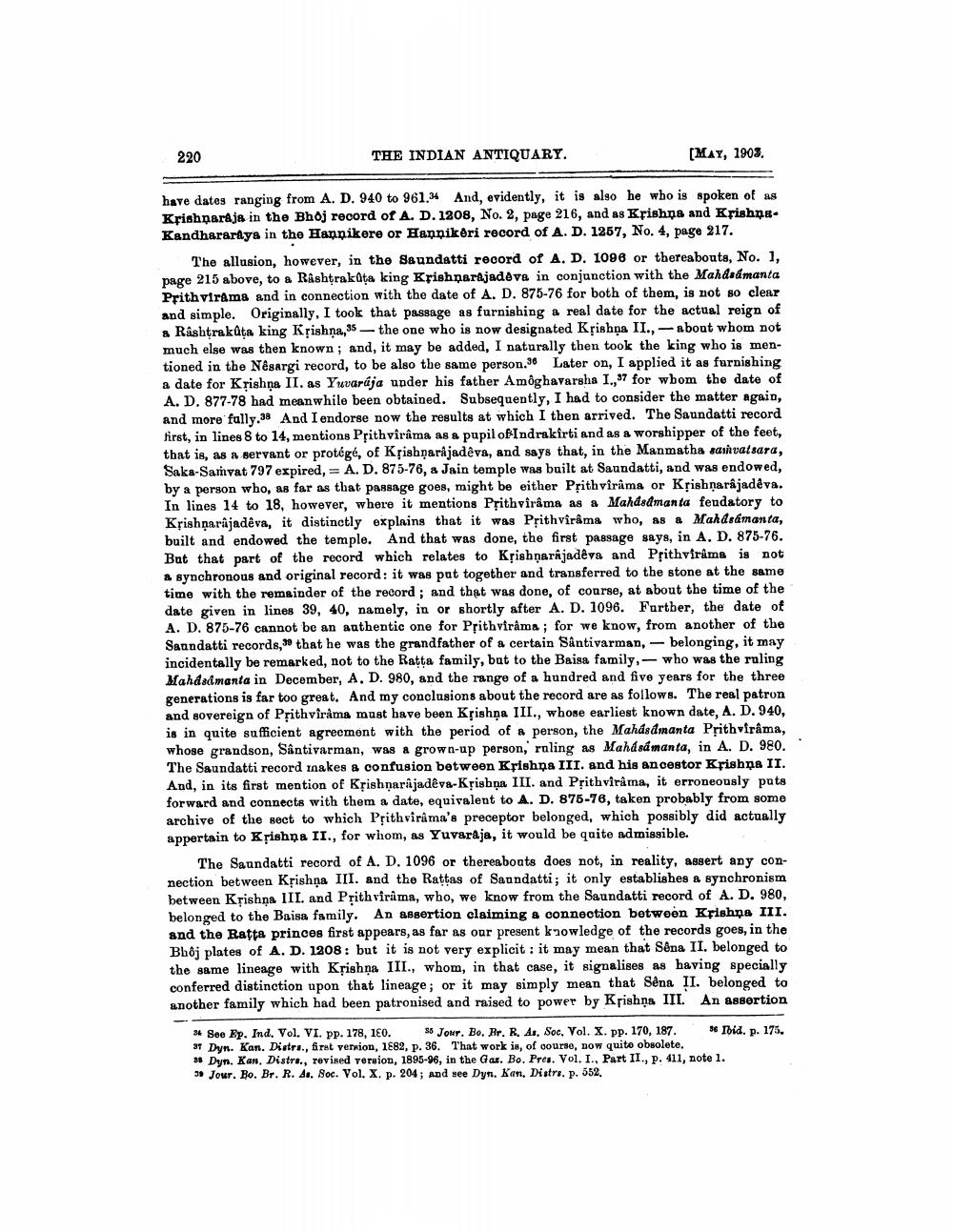________________
220
THE INDIAN ANTIQUARY.
[MAY, 1903.
have dates ranging from A. D. 940 to 961.34 And, evidently, it is also he who is spoken of as Krishnaraja in the Bhoj record of A. D. 1208, No. 2, page 216, and as Krishna and Krishna. Kandharardys in the Hanņikere or Hannikéri record of A. D. 1267, No. 4, page 217.
The allusion, however, in the Saundatti record of A. D. 1098 or thereabouts, No. 1, page 215 above, to a Rashtrakata king Krishnarajadeva in conjunction with the Mahdadmanta Prithvirams and in connection with the date of A. D. 875-76 for both of them, is not so clear and simple. Originally, I took that passage as furnishing a real date for the actual reign of & Rashtrakůta king Krishna, 35 - the one who is now designated Krishna II., - about whom not much else was then known; and, it may be added, I naturally then took the king who is mentioned in the Nêsargi record, to be also the same person. Later on, I applied it as furnishing a date for Krishņa II. as Yuvarája under his father Amoghavarsha I.,7 for wbom the date of A. D. 877-78 had meanwhile been obtained. Subsequently, I had to consider the matter again, and more fully.38 And I endorse now the results at which I then arrived. The Saundatti record first, in lines 8 to 14, mentions Prithvirama as a pupil of Indrakirti and as a worshipper of the feet, that is, as a servant or protégé, of Kộishnarajadêva, and says that, in the Manmatha samvatsara, Saka-Samvat 797 expired, = A. D. 875-76, a Jain temple was built at Saundatti, and was endowed, by a person who, as far as that passage goes, might be either Přithvirâma or Kộishnarajadêva. In lines 14 to 18, however, where it mentions Prithvirama as a Mahdsdmanta fendatory to Krishnarajadêva, it distinctly explains that it was Pțithvirama who, as a Mahdsamanta, built and endowed the temple. And that was done, the first passage says, in A. D. 875-76. But that part of the record which relates to Krishnarajadêva and Prithviráma is not a synchronous and original record: it was pat together and transferred to the stone at the same time with the remainder of the record; and that was done, of course, at about the time of the date given in lines 39, 40, namely, in or shortly after A. D. 1096. Further, the date of A. D. 875-76 cannot be an authentic one for Prithvirama; for we know, from another of the Sanndatti records, that he was the grandfather of a certain Sântivarman, - belonging, it may incidentally be remarked, not to the Ratta family, but to the Baisa family, who was the ruling Mahdaa manta in December, A. D. 980, and the range of a hundred and five years for the three generations is far too great. And my conclusions about the record are as follows. The real patron and sovereign of Přithvirama must have been Krishna III., whose earliest known date, A. D. 940, is in quite sufficient agreement with the period of a person, the Mahdsdmanta Prithvirama, whose grandson, Sântivarman, was a grown-up person, ruling as Mahd så manta, in A. D. 980. The Saundatti record makes & confusion between Krishna III. and his ancestor Krishna II. And, in its first mention of Kishnarajadêva-Křishņa III. and Prithvirâma, it erroneously puts forward and connects with them a date, equivalent to A. D. 875-76, taken probably from some archive of the sect to which Prithvirama's preceptor belonged, which possibly did actually appertain to Krishna II., for whom, as Yuvaraja, it would be quite admissible.
The Saundatti record of A. D. 1096 or thereabouts does not, in reality, aggert any connection between Krishna III. and the Rattas of Saundatti; it only establishes a synchronism between Krishna III. and Prithvirama, who, we know from the Saundatti record of A. D. 980, belonged to the Baisa family. An assertion claiming a connection between Krishna III. and the Ratta princes first appears, as far as our present knowledge of the records goes, in the Bhojplates of A. D. 1208: but it is not very explicit : it may mean that Sêna II. belonged to the same lineage with Kệishna III., whom, in that case, it signalises as having specially conferred distinction upon that lineage; or it may simply mean that Séna II. belonged to another family which had been patronised and raised to power by Krishna III. An assertion
** See Ep. Ind. Vol. VI. pp. 178, 1€0. 58 Jour. B. Br. R. As. Soc. Vol. X. pp. 170, 187. * Ibid. p. 175. 31 Dyn. Kan. Dietro, first version, 1882, p. 36. That work is, of course, Dow quito obsolete. *Dyn. Kan. Distre., revised version, 1895-96, in the Gar. Bo. Pres. Vol. I. Part II., P. 411, note 1. 5 Jour. Bo. Br. R. 41. Soc. Vol. X. p. 204; and see Dyn. Kan, Distro. p. 552.




